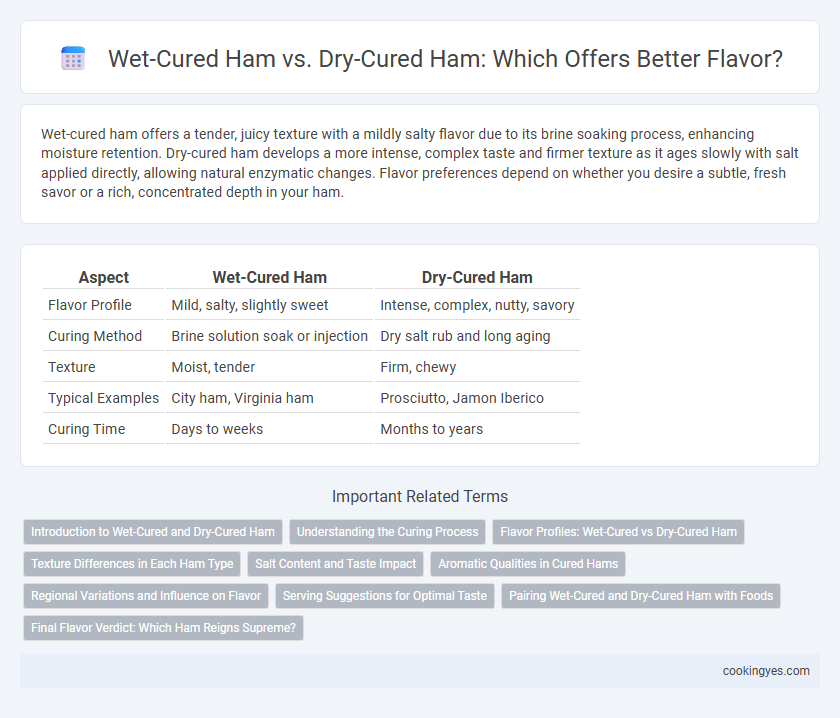Wet-cured ham offers a tender, juicy texture with a mildly salty flavor due to its brine soaking process, enhancing moisture retention. Dry-cured ham develops a more intense, complex taste and firmer texture as it ages slowly with salt applied directly, allowing natural enzymatic changes. Flavor preferences depend on whether you desire a subtle, fresh savor or a rich, concentrated depth in your ham.
Table of Comparison
| Aspect | Wet-Cured Ham | Dry-Cured Ham |
|---|---|---|
| Flavor Profile | Mild, salty, slightly sweet | Intense, complex, nutty, savory |
| Curing Method | Brine solution soak or injection | Dry salt rub and long aging |
| Texture | Moist, tender | Firm, chewy |
| Typical Examples | City ham, Virginia ham | Prosciutto, Jamon Iberico |
| Curing Time | Days to weeks | Months to years |
Introduction to Wet-Cured and Dry-Cured Ham
Wet-cured ham undergoes brining in a saltwater solution, resulting in a moist texture and a mild, slightly salty flavor profile favored in many contemporary recipes. Dry-cured ham is treated with a dry mixture of salt and spices, then aged for extended periods, developing a complex, intense flavor with a firm, chewy texture prized in artisanal charcuterie. The curing method directly influences the ham's moisture content, flavor depth, and culinary uses, distinguishing wet-cured hams like city hams from dry-cured varieties such as prosciutto or jamon iberico.
Understanding the Curing Process
Wet-cured ham undergoes a brining process where the meat is soaked or injected with a saltwater solution, enhancing moisture retention and resulting in a milder, juicier flavor profile. Dry-cured ham relies on a salt-rubbing technique followed by air drying over weeks or months, intensifying flavor concentration and producing a firmer texture with complex, savory notes. Understanding these curing processes highlights the impact of moisture levels and salt penetration on the distinct taste and texture characteristics of wet-cured versus dry-cured ham.
Flavor Profiles: Wet-Cured vs Dry-Cured Ham
Wet-cured ham offers a milder, juicier flavor due to brine soaking, which infuses the meat with salt and spices, resulting in a tender texture. Dry-cured ham develops a more intense, concentrated taste from prolonged air-drying and aging, enhancing umami and smoky notes. Differences in curing techniques significantly impact flavor depth and aroma, making dry-cured hams like prosciutto richer and wetter-cured varieties like city ham more delicate.
Texture Differences in Each Ham Type
Wet-cured ham features a moist, tender texture due to the brining process that infuses the meat with saltwater and sometimes sugar or spices. Dry-cured ham develops a firm, dense texture as it cures slowly through salt and air, concentrating flavors and reducing moisture. The contrast in texture significantly influences the eating experience, with wet-cured ham offering softness and juiciness, while dry-cured ham provides a chewier, more intense bite.
Salt Content and Taste Impact
Wet-cured ham typically contains higher moisture and salt content due to brining, resulting in a saltier and juicier flavor profile. Dry-cured ham undergoes a longer curing process with coarse salt, leading to a more concentrated, intense, and savory taste with a firmer texture. The salt content in dry-cured ham enhances umami while reducing water activity, which profoundly develops complex flavors compared to the milder, salt-forward taste of wet-cured varieties.
Aromatic Qualities in Cured Hams
Wet-cured ham offers a milder, salt-forward flavor profile due to its brine solution, which enhances moisture retention and produces subtle aromatic notes of herbs and spices infused during curing. Dry-cured ham develops richer, more complex aromas with pronounced nutty and earthy undertones, stemming from prolonged air-drying and enzymatic aging processes that concentrate natural flavors. The aromatic qualities in dry-cured ham often include hints of aged cheese, fermented fruit, and toasted nuts, distinguishing it from the fresher, lighter scent of wet-cured varieties.
Regional Variations and Influence on Flavor
Wet-cured ham, prevalent in regions like the United States and Northern Europe, undergoes brining that imparts a moist, mild, and slightly salty flavor profile, often favored for its tender texture. Dry-cured ham, common in Mediterranean areas such as Spain and Italy, relies on salt and air-drying, producing a concentrated, complex, and robust taste with a firm texture influenced by local climate and aging duration. Regional variations in humidity, temperature, and curing traditions directly affect the enzymatic and microbial processes, resulting in distinct aromatic compounds and flavor intensity unique to each curing method.
Serving Suggestions for Optimal Taste
Wet-cured ham offers a moist, tender texture ideal for slicing thinly and serving cold in sandwiches or salads, enhancing its subtly salty flavor. Dry-cured ham, such as prosciutto or jamon iberico, boasts a firmer texture and intense, complex taste best enjoyed thinly sliced at room temperature, paired with fruits, cheeses, or crusty bread to highlight its savory richness. Serving wet-cured ham warm after glazing or roasting brings out its juiciness, while dry-cured ham benefits from minimal cooking to preserve its intricate flavors.
Pairing Wet-Cured and Dry-Cured Ham with Foods
Wet-cured ham offers a moist, salty flavor profile that pairs excellently with sweet fruits, such as melon and pineapple, as well as creamy cheeses like brie or mozzarella. Dry-cured ham, known for its intense, concentrated taste and firmer texture, complements bold accompaniments like aged cheeses, olives, nuts, and robust red wines. Pairing strategies leverage wet-cured ham's juiciness with light, fresh foods, while dry-cured ham matches well with savory, intense flavors and complex wines for a balanced culinary experience.
Final Flavor Verdict: Which Ham Reigns Supreme?
Wet-cured ham delivers a moist, tender texture with a mildly salty and slightly sweet profile due to its brining process, making it ideal for those who prefer a subtle, succulent taste. Dry-cured ham offers a more intense, complex flavor characterized by rich umami notes and a firmer texture created through extended air-drying and aging. The final flavor verdict favors dry-cured ham for connoisseurs seeking depth and boldness, while wet-cured ham suits those desiring a delicate, juicy experience.
Wet-cured ham vs dry-cured ham for flavor Infographic

 cookingyes.com
cookingyes.com